Comparison of IAS 16 and AASB 116
VerifiedAdded on 2020/10/22
|7
|1677
|374
AI Summary
The provided assignment compares the treatment of fixed assets and properties according to IAS 16/AASB 116. It discusses how valuations are recorded in books using different accounting models. The focus is on the revaluation model followed by Good Ltd., which earns a $20,000 profit during the year, contrasting with Better Ltd.'s cost model, resulting in a loss of -$6,670. The assignment concludes that financial accounting aspects are summarized in terms of recording and treatment of fixed assets and properties according to IAS 16/AASB 116.
Contribute Materials
Your contribution can guide someone’s learning journey. Share your
documents today.
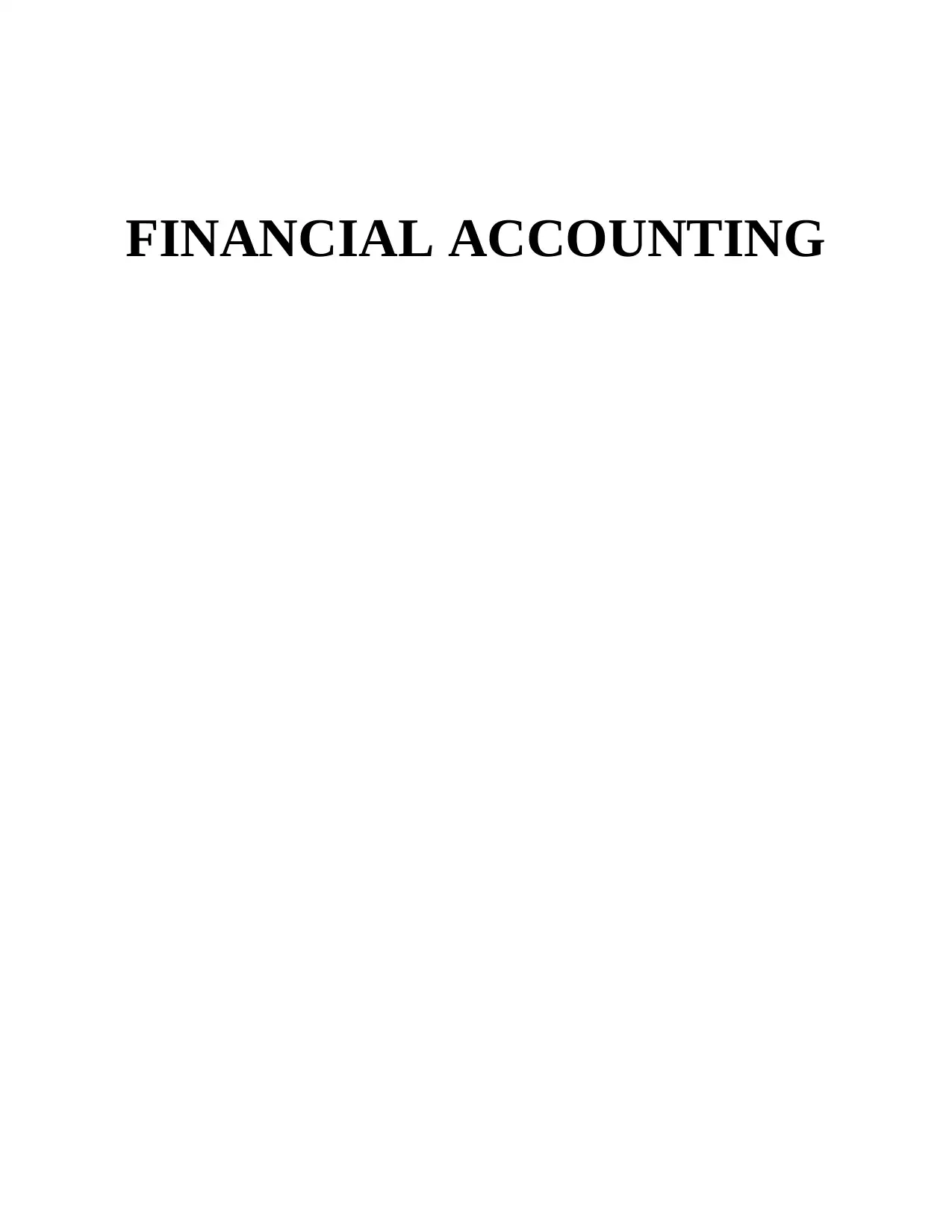
FINANCIAL ACCOUNTING
Secure Best Marks with AI Grader
Need help grading? Try our AI Grader for instant feedback on your assignments.
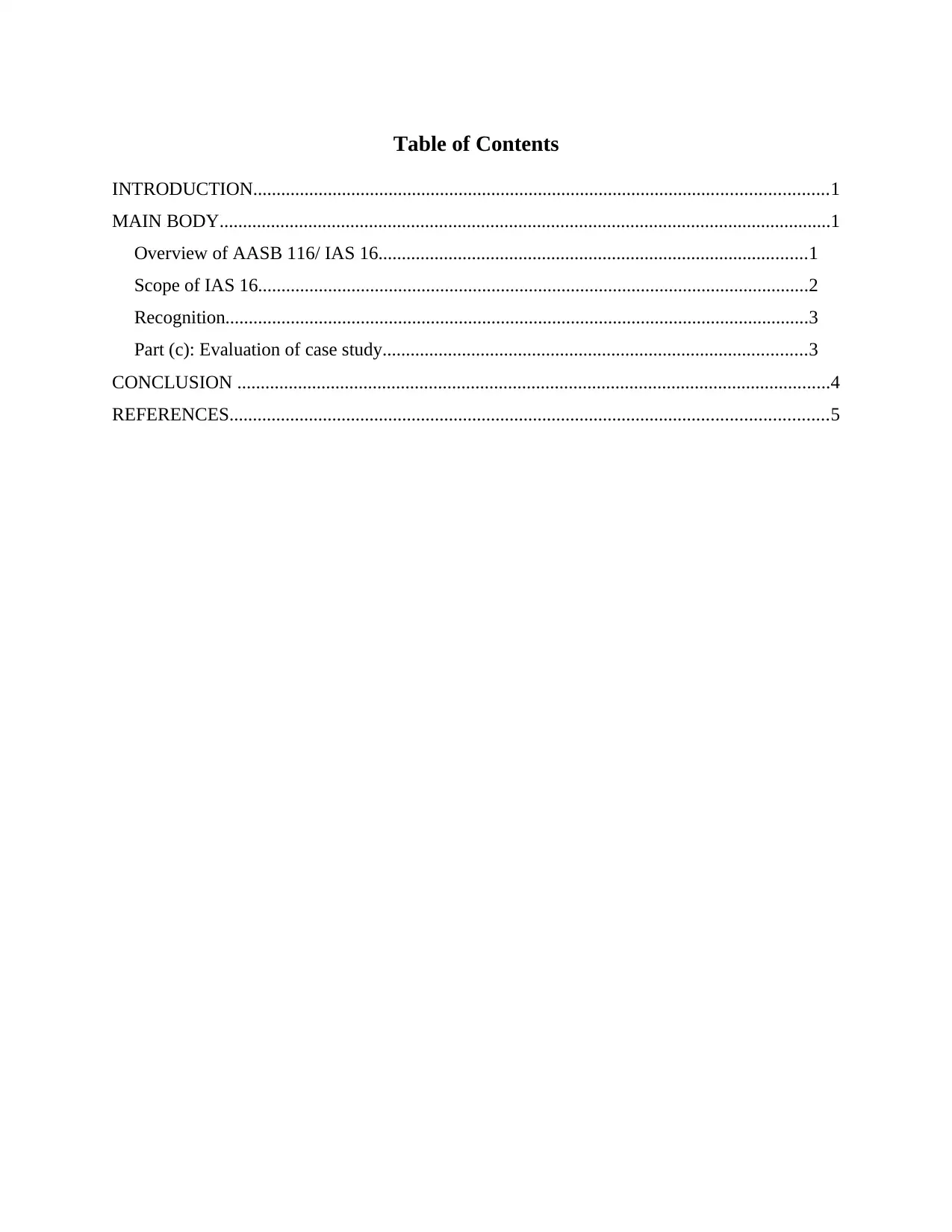
Table of Contents
INTRODUCTION...........................................................................................................................1
MAIN BODY...................................................................................................................................1
Overview of AASB 116/ IAS 16............................................................................................1
Scope of IAS 16......................................................................................................................2
Recognition.............................................................................................................................3
Part (c): Evaluation of case study...........................................................................................3
CONCLUSION ...............................................................................................................................4
REFERENCES................................................................................................................................5
INTRODUCTION...........................................................................................................................1
MAIN BODY...................................................................................................................................1
Overview of AASB 116/ IAS 16............................................................................................1
Scope of IAS 16......................................................................................................................2
Recognition.............................................................................................................................3
Part (c): Evaluation of case study...........................................................................................3
CONCLUSION ...............................................................................................................................4
REFERENCES................................................................................................................................5
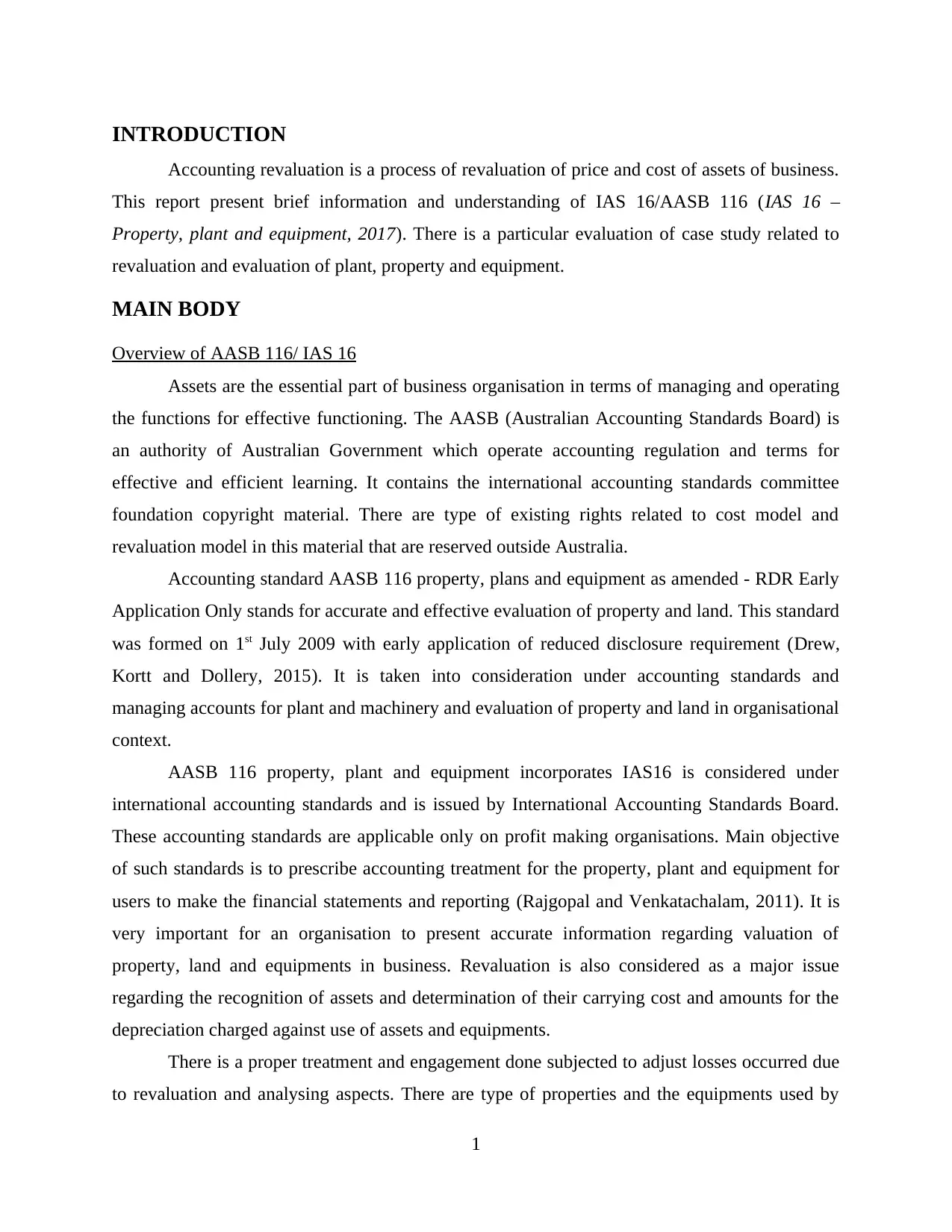
INTRODUCTION
Accounting revaluation is a process of revaluation of price and cost of assets of business.
This report present brief information and understanding of IAS 16/AASB 116 (IAS 16 –
Property, plant and equipment, 2017). There is a particular evaluation of case study related to
revaluation and evaluation of plant, property and equipment.
MAIN BODY
Overview of AASB 116/ IAS 16
Assets are the essential part of business organisation in terms of managing and operating
the functions for effective functioning. The AASB (Australian Accounting Standards Board) is
an authority of Australian Government which operate accounting regulation and terms for
effective and efficient learning. It contains the international accounting standards committee
foundation copyright material. There are type of existing rights related to cost model and
revaluation model in this material that are reserved outside Australia.
Accounting standard AASB 116 property, plans and equipment as amended - RDR Early
Application Only stands for accurate and effective evaluation of property and land. This standard
was formed on 1st July 2009 with early application of reduced disclosure requirement (Drew,
Kortt and Dollery, 2015). It is taken into consideration under accounting standards and
managing accounts for plant and machinery and evaluation of property and land in organisational
context.
AASB 116 property, plant and equipment incorporates IAS16 is considered under
international accounting standards and is issued by International Accounting Standards Board.
These accounting standards are applicable only on profit making organisations. Main objective
of such standards is to prescribe accounting treatment for the property, plant and equipment for
users to make the financial statements and reporting (Rajgopal and Venkatachalam, 2011). It is
very important for an organisation to present accurate information regarding valuation of
property, land and equipments in business. Revaluation is also considered as a major issue
regarding the recognition of assets and determination of their carrying cost and amounts for the
depreciation charged against use of assets and equipments.
There is a proper treatment and engagement done subjected to adjust losses occurred due
to revaluation and analysing aspects. There are type of properties and the equipments used by
1
Accounting revaluation is a process of revaluation of price and cost of assets of business.
This report present brief information and understanding of IAS 16/AASB 116 (IAS 16 –
Property, plant and equipment, 2017). There is a particular evaluation of case study related to
revaluation and evaluation of plant, property and equipment.
MAIN BODY
Overview of AASB 116/ IAS 16
Assets are the essential part of business organisation in terms of managing and operating
the functions for effective functioning. The AASB (Australian Accounting Standards Board) is
an authority of Australian Government which operate accounting regulation and terms for
effective and efficient learning. It contains the international accounting standards committee
foundation copyright material. There are type of existing rights related to cost model and
revaluation model in this material that are reserved outside Australia.
Accounting standard AASB 116 property, plans and equipment as amended - RDR Early
Application Only stands for accurate and effective evaluation of property and land. This standard
was formed on 1st July 2009 with early application of reduced disclosure requirement (Drew,
Kortt and Dollery, 2015). It is taken into consideration under accounting standards and
managing accounts for plant and machinery and evaluation of property and land in organisational
context.
AASB 116 property, plant and equipment incorporates IAS16 is considered under
international accounting standards and is issued by International Accounting Standards Board.
These accounting standards are applicable only on profit making organisations. Main objective
of such standards is to prescribe accounting treatment for the property, plant and equipment for
users to make the financial statements and reporting (Rajgopal and Venkatachalam, 2011). It is
very important for an organisation to present accurate information regarding valuation of
property, land and equipments in business. Revaluation is also considered as a major issue
regarding the recognition of assets and determination of their carrying cost and amounts for the
depreciation charged against use of assets and equipments.
There is a proper treatment and engagement done subjected to adjust losses occurred due
to revaluation and analysing aspects. There are type of properties and the equipments used by
1
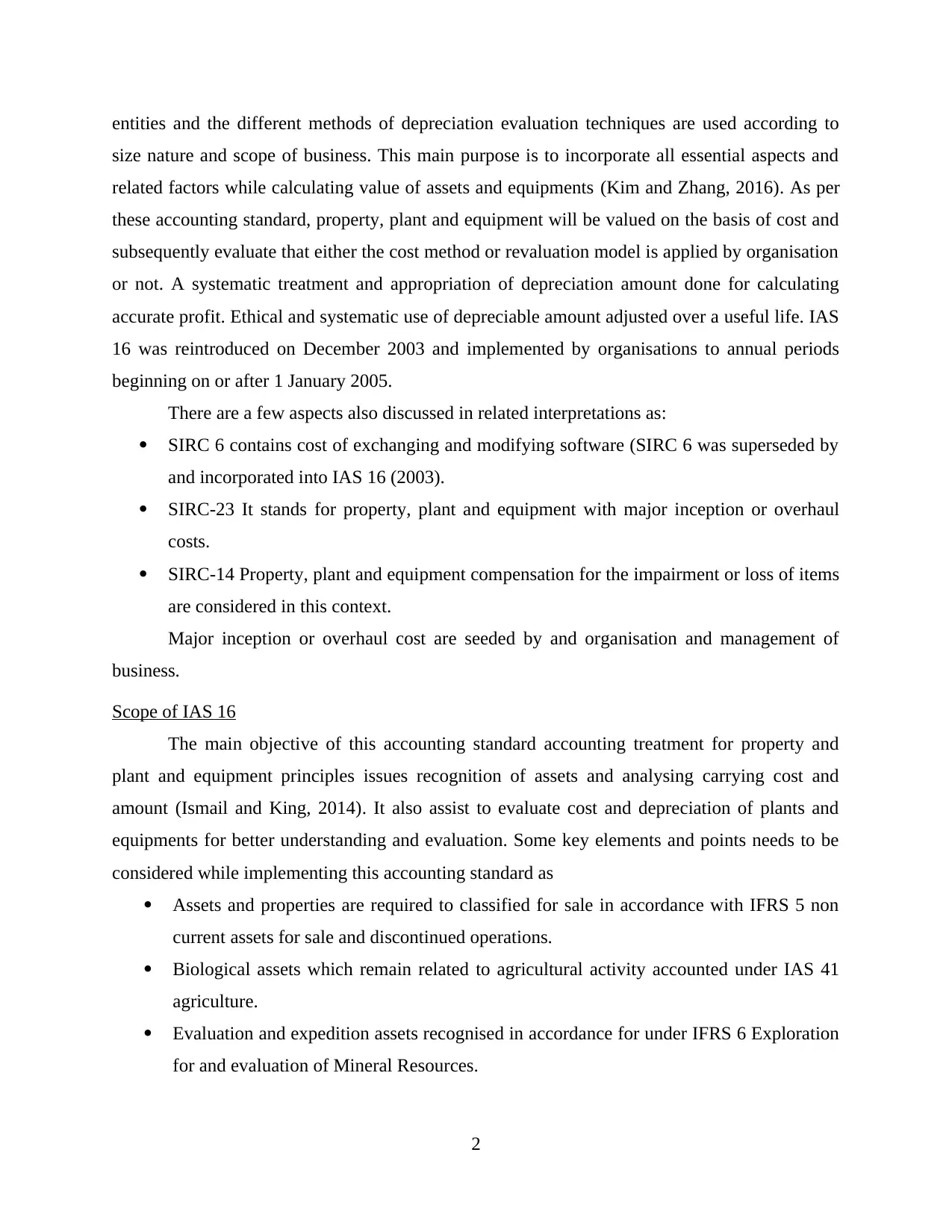
entities and the different methods of depreciation evaluation techniques are used according to
size nature and scope of business. This main purpose is to incorporate all essential aspects and
related factors while calculating value of assets and equipments (Kim and Zhang, 2016). As per
these accounting standard, property, plant and equipment will be valued on the basis of cost and
subsequently evaluate that either the cost method or revaluation model is applied by organisation
or not. A systematic treatment and appropriation of depreciation amount done for calculating
accurate profit. Ethical and systematic use of depreciable amount adjusted over a useful life. IAS
16 was reintroduced on December 2003 and implemented by organisations to annual periods
beginning on or after 1 January 2005.
There are a few aspects also discussed in related interpretations as:
SIRC 6 contains cost of exchanging and modifying software (SIRC 6 was superseded by
and incorporated into IAS 16 (2003).
SIRC-23 It stands for property, plant and equipment with major inception or overhaul
costs.
SIRC-14 Property, plant and equipment compensation for the impairment or loss of items
are considered in this context.
Major inception or overhaul cost are seeded by and organisation and management of
business.
Scope of IAS 16
The main objective of this accounting standard accounting treatment for property and
plant and equipment principles issues recognition of assets and analysing carrying cost and
amount (Ismail and King, 2014). It also assist to evaluate cost and depreciation of plants and
equipments for better understanding and evaluation. Some key elements and points needs to be
considered while implementing this accounting standard as
Assets and properties are required to classified for sale in accordance with IFRS 5 non
current assets for sale and discontinued operations.
Biological assets which remain related to agricultural activity accounted under IAS 41
agriculture.
Evaluation and expedition assets recognised in accordance for under IFRS 6 Exploration
for and evaluation of Mineral Resources.
2
size nature and scope of business. This main purpose is to incorporate all essential aspects and
related factors while calculating value of assets and equipments (Kim and Zhang, 2016). As per
these accounting standard, property, plant and equipment will be valued on the basis of cost and
subsequently evaluate that either the cost method or revaluation model is applied by organisation
or not. A systematic treatment and appropriation of depreciation amount done for calculating
accurate profit. Ethical and systematic use of depreciable amount adjusted over a useful life. IAS
16 was reintroduced on December 2003 and implemented by organisations to annual periods
beginning on or after 1 January 2005.
There are a few aspects also discussed in related interpretations as:
SIRC 6 contains cost of exchanging and modifying software (SIRC 6 was superseded by
and incorporated into IAS 16 (2003).
SIRC-23 It stands for property, plant and equipment with major inception or overhaul
costs.
SIRC-14 Property, plant and equipment compensation for the impairment or loss of items
are considered in this context.
Major inception or overhaul cost are seeded by and organisation and management of
business.
Scope of IAS 16
The main objective of this accounting standard accounting treatment for property and
plant and equipment principles issues recognition of assets and analysing carrying cost and
amount (Ismail and King, 2014). It also assist to evaluate cost and depreciation of plants and
equipments for better understanding and evaluation. Some key elements and points needs to be
considered while implementing this accounting standard as
Assets and properties are required to classified for sale in accordance with IFRS 5 non
current assets for sale and discontinued operations.
Biological assets which remain related to agricultural activity accounted under IAS 41
agriculture.
Evaluation and expedition assets recognised in accordance for under IFRS 6 Exploration
for and evaluation of Mineral Resources.
2
Secure Best Marks with AI Grader
Need help grading? Try our AI Grader for instant feedback on your assignments.
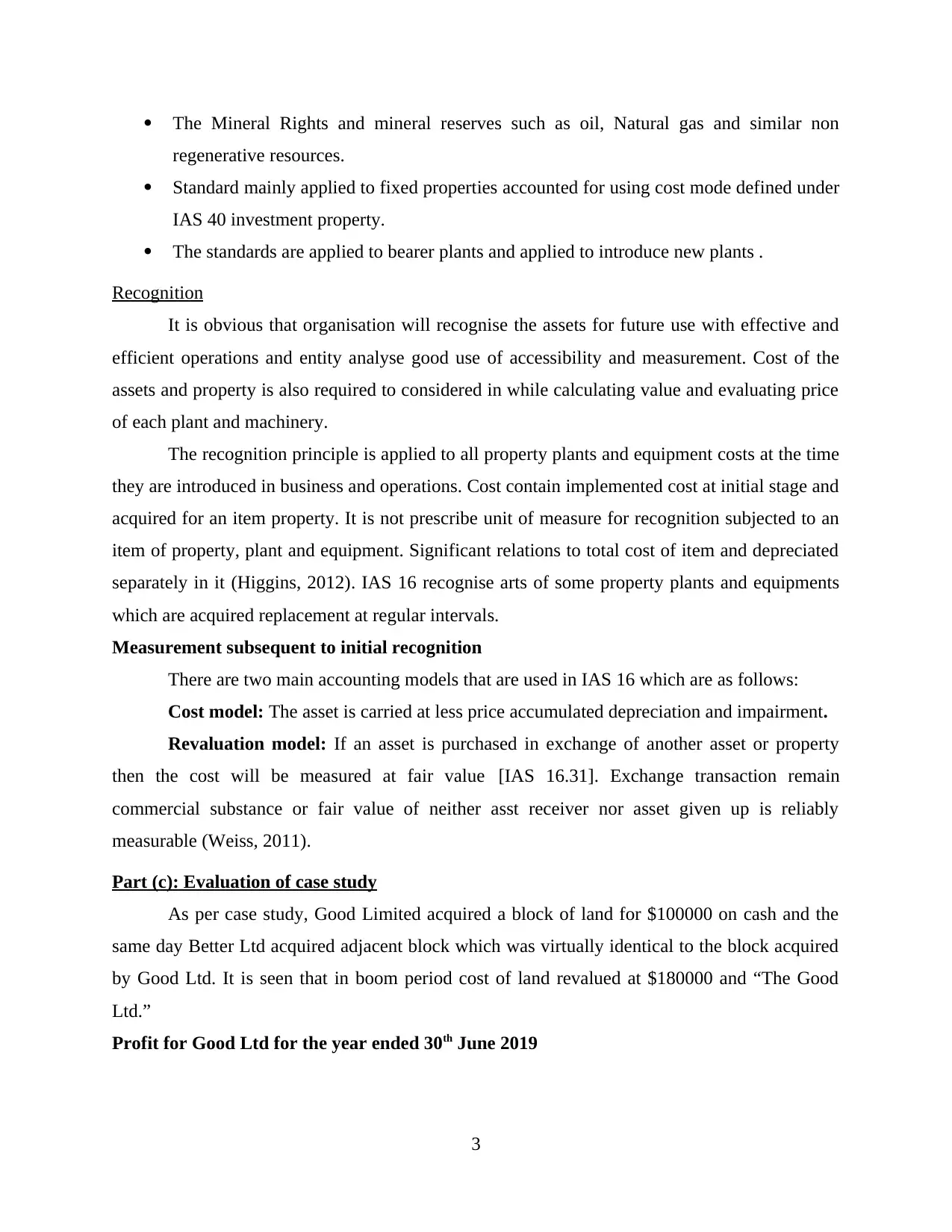
The Mineral Rights and mineral reserves such as oil, Natural gas and similar non
regenerative resources.
Standard mainly applied to fixed properties accounted for using cost mode defined under
IAS 40 investment property.
The standards are applied to bearer plants and applied to introduce new plants .
Recognition
It is obvious that organisation will recognise the assets for future use with effective and
efficient operations and entity analyse good use of accessibility and measurement. Cost of the
assets and property is also required to considered in while calculating value and evaluating price
of each plant and machinery.
The recognition principle is applied to all property plants and equipment costs at the time
they are introduced in business and operations. Cost contain implemented cost at initial stage and
acquired for an item property. It is not prescribe unit of measure for recognition subjected to an
item of property, plant and equipment. Significant relations to total cost of item and depreciated
separately in it (Higgins, 2012). IAS 16 recognise arts of some property plants and equipments
which are acquired replacement at regular intervals.
Measurement subsequent to initial recognition
There are two main accounting models that are used in IAS 16 which are as follows:
Cost model: The asset is carried at less price accumulated depreciation and impairment.
Revaluation model: If an asset is purchased in exchange of another asset or property
then the cost will be measured at fair value [IAS 16.31]. Exchange transaction remain
commercial substance or fair value of neither asst receiver nor asset given up is reliably
measurable (Weiss, 2011).
Part (c): Evaluation of case study
As per case study, Good Limited acquired a block of land for $100000 on cash and the
same day Better Ltd acquired adjacent block which was virtually identical to the block acquired
by Good Ltd. It is seen that in boom period cost of land revalued at $180000 and “The Good
Ltd.”
Profit for Good Ltd for the year ended 30th June 2019
3
regenerative resources.
Standard mainly applied to fixed properties accounted for using cost mode defined under
IAS 40 investment property.
The standards are applied to bearer plants and applied to introduce new plants .
Recognition
It is obvious that organisation will recognise the assets for future use with effective and
efficient operations and entity analyse good use of accessibility and measurement. Cost of the
assets and property is also required to considered in while calculating value and evaluating price
of each plant and machinery.
The recognition principle is applied to all property plants and equipment costs at the time
they are introduced in business and operations. Cost contain implemented cost at initial stage and
acquired for an item property. It is not prescribe unit of measure for recognition subjected to an
item of property, plant and equipment. Significant relations to total cost of item and depreciated
separately in it (Higgins, 2012). IAS 16 recognise arts of some property plants and equipments
which are acquired replacement at regular intervals.
Measurement subsequent to initial recognition
There are two main accounting models that are used in IAS 16 which are as follows:
Cost model: The asset is carried at less price accumulated depreciation and impairment.
Revaluation model: If an asset is purchased in exchange of another asset or property
then the cost will be measured at fair value [IAS 16.31]. Exchange transaction remain
commercial substance or fair value of neither asst receiver nor asset given up is reliably
measurable (Weiss, 2011).
Part (c): Evaluation of case study
As per case study, Good Limited acquired a block of land for $100000 on cash and the
same day Better Ltd acquired adjacent block which was virtually identical to the block acquired
by Good Ltd. It is seen that in boom period cost of land revalued at $180000 and “The Good
Ltd.”
Profit for Good Ltd for the year ended 30th June 2019
3
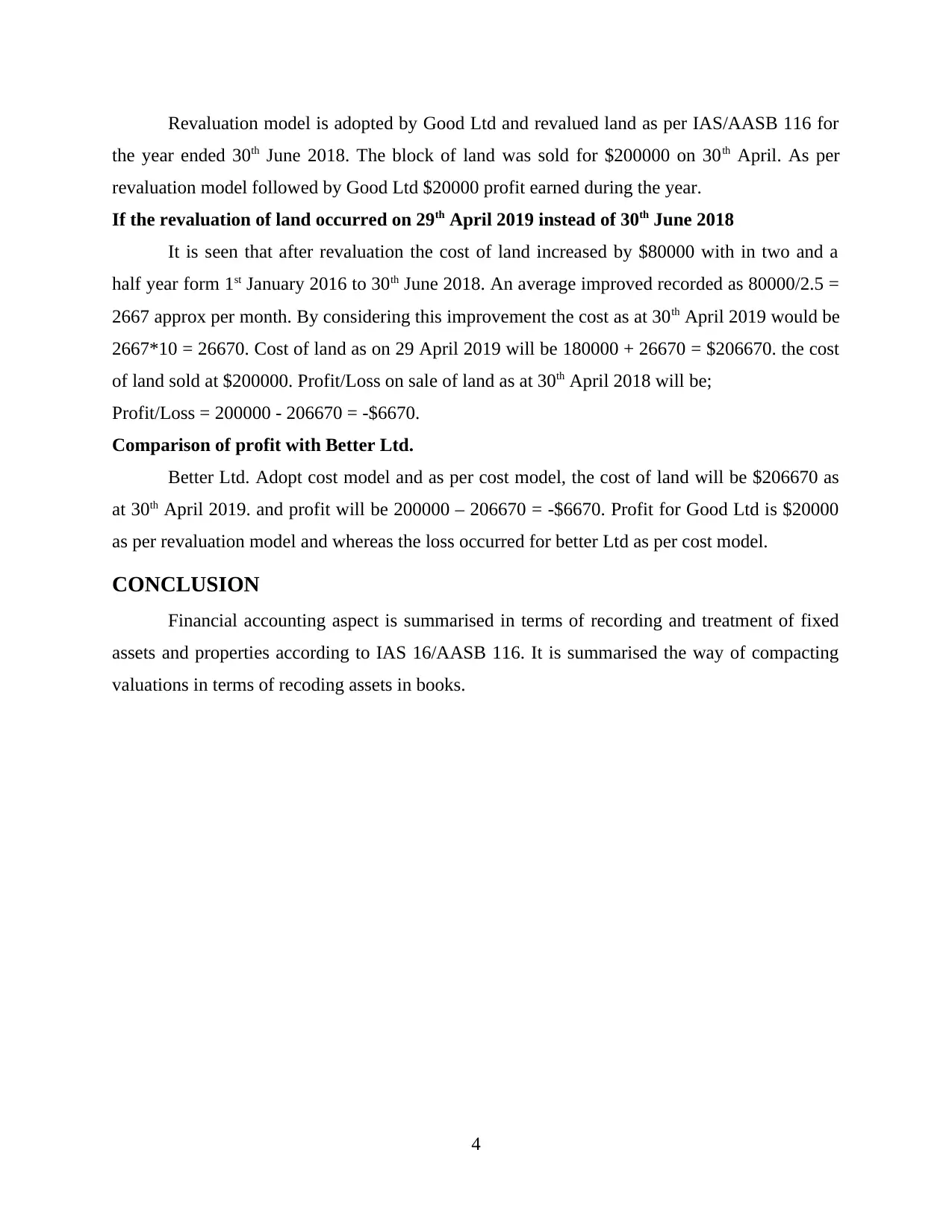
Revaluation model is adopted by Good Ltd and revalued land as per IAS/AASB 116 for
the year ended 30th June 2018. The block of land was sold for $200000 on 30th April. As per
revaluation model followed by Good Ltd $20000 profit earned during the year.
If the revaluation of land occurred on 29th April 2019 instead of 30th June 2018
It is seen that after revaluation the cost of land increased by $80000 with in two and a
half year form 1st January 2016 to 30th June 2018. An average improved recorded as 80000/2.5 =
2667 approx per month. By considering this improvement the cost as at 30th April 2019 would be
2667*10 = 26670. Cost of land as on 29 April 2019 will be 180000 + 26670 = $206670. the cost
of land sold at $200000. Profit/Loss on sale of land as at 30th April 2018 will be;
Profit/Loss = 200000 - 206670 = -$6670.
Comparison of profit with Better Ltd.
Better Ltd. Adopt cost model and as per cost model, the cost of land will be $206670 as
at 30th April 2019. and profit will be 200000 – 206670 = -$6670. Profit for Good Ltd is $20000
as per revaluation model and whereas the loss occurred for better Ltd as per cost model.
CONCLUSION
Financial accounting aspect is summarised in terms of recording and treatment of fixed
assets and properties according to IAS 16/AASB 116. It is summarised the way of compacting
valuations in terms of recoding assets in books.
4
the year ended 30th June 2018. The block of land was sold for $200000 on 30th April. As per
revaluation model followed by Good Ltd $20000 profit earned during the year.
If the revaluation of land occurred on 29th April 2019 instead of 30th June 2018
It is seen that after revaluation the cost of land increased by $80000 with in two and a
half year form 1st January 2016 to 30th June 2018. An average improved recorded as 80000/2.5 =
2667 approx per month. By considering this improvement the cost as at 30th April 2019 would be
2667*10 = 26670. Cost of land as on 29 April 2019 will be 180000 + 26670 = $206670. the cost
of land sold at $200000. Profit/Loss on sale of land as at 30th April 2018 will be;
Profit/Loss = 200000 - 206670 = -$6670.
Comparison of profit with Better Ltd.
Better Ltd. Adopt cost model and as per cost model, the cost of land will be $206670 as
at 30th April 2019. and profit will be 200000 – 206670 = -$6670. Profit for Good Ltd is $20000
as per revaluation model and whereas the loss occurred for better Ltd as per cost model.
CONCLUSION
Financial accounting aspect is summarised in terms of recording and treatment of fixed
assets and properties according to IAS 16/AASB 116. It is summarised the way of compacting
valuations in terms of recoding assets in books.
4
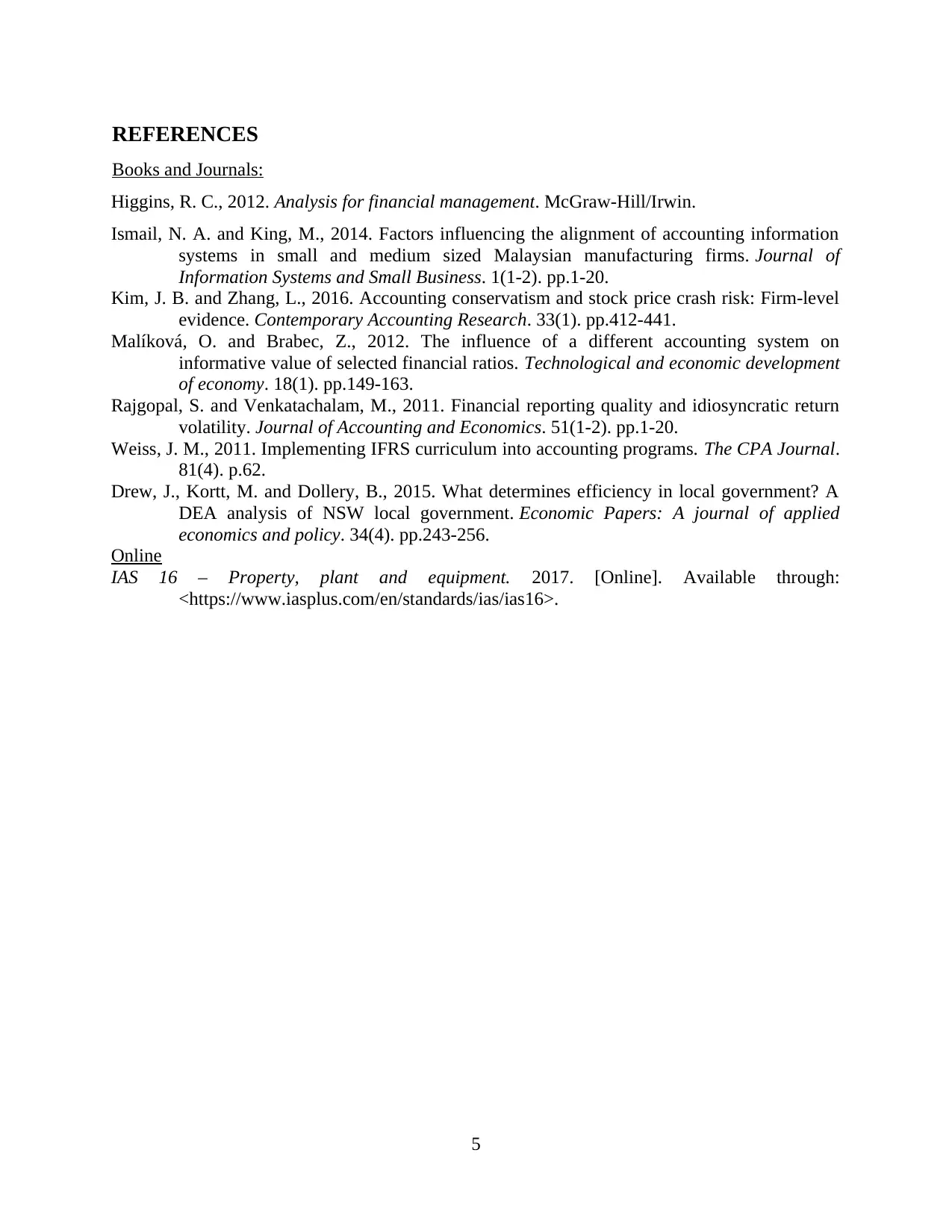
REFERENCES
Books and Journals:
Higgins, R. C., 2012. Analysis for financial management. McGraw-Hill/Irwin.
Ismail, N. A. and King, M., 2014. Factors influencing the alignment of accounting information
systems in small and medium sized Malaysian manufacturing firms. Journal of
Information Systems and Small Business. 1(1-2). pp.1-20.
Kim, J. B. and Zhang, L., 2016. Accounting conservatism and stock price crash risk: Firm‐level
evidence. Contemporary Accounting Research. 33(1). pp.412-441.
Malíková, O. and Brabec, Z., 2012. The influence of a different accounting system on
informative value of selected financial ratios. Technological and economic development
of economy. 18(1). pp.149-163.
Rajgopal, S. and Venkatachalam, M., 2011. Financial reporting quality and idiosyncratic return
volatility. Journal of Accounting and Economics. 51(1-2). pp.1-20.
Weiss, J. M., 2011. Implementing IFRS curriculum into accounting programs. The CPA Journal.
81(4). p.62.
Drew, J., Kortt, M. and Dollery, B., 2015. What determines efficiency in local government? A
DEA analysis of NSW local government. Economic Papers: A journal of applied
economics and policy. 34(4). pp.243-256.
Online
IAS 16 – Property, plant and equipment. 2017. [Online]. Available through:
<https://www.iasplus.com/en/standards/ias/ias16>.
5
Books and Journals:
Higgins, R. C., 2012. Analysis for financial management. McGraw-Hill/Irwin.
Ismail, N. A. and King, M., 2014. Factors influencing the alignment of accounting information
systems in small and medium sized Malaysian manufacturing firms. Journal of
Information Systems and Small Business. 1(1-2). pp.1-20.
Kim, J. B. and Zhang, L., 2016. Accounting conservatism and stock price crash risk: Firm‐level
evidence. Contemporary Accounting Research. 33(1). pp.412-441.
Malíková, O. and Brabec, Z., 2012. The influence of a different accounting system on
informative value of selected financial ratios. Technological and economic development
of economy. 18(1). pp.149-163.
Rajgopal, S. and Venkatachalam, M., 2011. Financial reporting quality and idiosyncratic return
volatility. Journal of Accounting and Economics. 51(1-2). pp.1-20.
Weiss, J. M., 2011. Implementing IFRS curriculum into accounting programs. The CPA Journal.
81(4). p.62.
Drew, J., Kortt, M. and Dollery, B., 2015. What determines efficiency in local government? A
DEA analysis of NSW local government. Economic Papers: A journal of applied
economics and policy. 34(4). pp.243-256.
Online
IAS 16 – Property, plant and equipment. 2017. [Online]. Available through:
<https://www.iasplus.com/en/standards/ias/ias16>.
5
1 out of 7
Related Documents
Your All-in-One AI-Powered Toolkit for Academic Success.
+13062052269
info@desklib.com
Available 24*7 on WhatsApp / Email
![[object Object]](/_next/static/media/star-bottom.7253800d.svg)
Unlock your academic potential
© 2024 | Zucol Services PVT LTD | All rights reserved.



